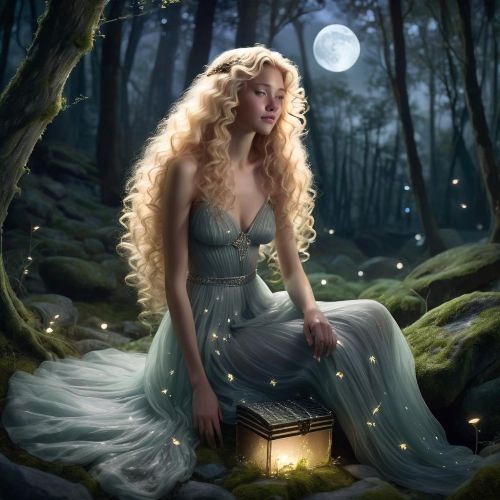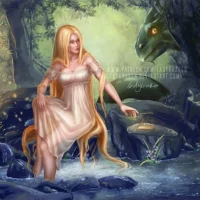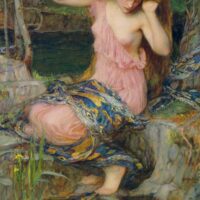
Xana : The Enchanting Spirit
Listen
At a glance
| Description | |
|---|---|
| Origin | Southern European Mythology |
| Classification | Spirits |
| Family Members | N/A |
| Region | Spain |
| Associated With | Enchanting, Shapeshifting, Hypnosis |
Xana
Introduction
The Xana is one of the most enchanting beings in Asturian mythology, a body of folklore rooted in the mountains and rivers of northern Spain. These mythical creatures are most often described as water fairies or spirits who live near fountains, lakes, waterfalls, and forest springs. The legends surrounding the Xana blend beauty with danger, highlighting the deep connection between humanity and the natural world. Unlike purely benevolent fairies of children’s tales, the Xana is a complex figure—sometimes generous and protective, at other times mischievous or vengeful. Her stories reflect Asturias’ Celtic heritage and its people’s reverence for the untamed landscape.
The name “Xana” is widely believed to derive from the Roman goddess Diana, a symbol of the hunt, forests, and the moon, although some folklorists suggest local linguistic roots. Regardless of its origin, the figure of the Xana has become a lasting emblem of Asturian identity. Even today, she represents both the mystical past and the living traditions of the region.
Physical Traits
The Xana is almost always portrayed as a young, extraordinarily beautiful woman. She is slender and delicate, with long flowing hair—usually blonde or light brown—that she is often seen combing with gold or silver combs. Her appearance radiates light, particularly near water, where she seems to merge with the shimmering reflections of the rivers and springs she inhabits.
Though she resembles a human, there is always something otherworldly about her presence. In many descriptions, she glows faintly under moonlight or dawn, and her voice has an ethereal quality. Unlike mortal women, she does not age, remaining forever youthful and luminous. In some traditions, Xanas wear traditional Asturian clothing, while in others, they are described in fine dresses that sparkle as though woven from water itself. These visual elements reinforce her connection to purity, beauty, and the sacredness of nature.
Family
The question of family is particularly fascinating in Xana folklore. While most myths describe them as solitary spirits, there are tales in which Xanas have children, known as xaninos. However, Xanas cannot nurse their own offspring, leading to one of the most intriguing motifs in Asturian folklore—the changeling exchange. According to tradition, a Xana will secretly swap her child for a human baby, leaving the xanín in the cradle.
The truth of the exchange could be revealed through certain tricks, often involving eggshells placed by the fire. If the baby was in fact a xanín, it would suddenly speak in an unnaturally wise voice, saying something like: “I was born a hundred years ago, and never have I seen so many eggshells roasting at once!” This strange declaration exposed the supernatural nature of the child. The changeling theme connects Xana legends to broader Celtic and Germanic folklore, showing how Asturian myths share patterns with other European traditions.
Some legends also suggest that a Xana could fall under a curse, transforming into a cuélebre—a fearsome dragon-like serpent—until released by a human’s intervention. In rare cases, this release led to marriage between the mortal and the Xana, creating dynasties that claimed descent from these magical beings, echoing how Greek heroes traced their ancestry to gods.
Other names
Although “Xana” is the most common name, variations exist across Iberian and Celtic folklore. In parts of Portugal, the word also appears in relation to mythological beings. Similar figures are known as Xaira, Inxangana, Ondina, Encantada, Moura, and Xacias in different traditions. They are closely related to the Anjanas of Cantabrian mythology and the Mouras Encantadas of Galicia and Portugal, which suggests a widespread cultural memory of water spirits across the Iberian Peninsula.
The connection with the Roman goddess Diana highlights the merging of classical influences with local folklore. In linguistic terms, “Xana” has also been linked with Greek-inspired names like Alexandra or Roxana, further emphasizing its ties to divine femininity and protective qualities. These overlapping names underline the rich cultural layering present in Asturian myth.
Powers and Abilities
The Xana is far more than a beautiful face; she is a being of immense magical power. Her voice is perhaps her most famous attribute. When she sings on spring or summer nights, her song has a hypnotic effect. Those with pure hearts feel peace, love, and serenity when listening, while those who are corrupt or ill-intentioned may suffer suffocation, madness, or despair. This dual effect highlights the Xana’s role as both a protector and a judge of human morality.
Xanas are often depicted as guardians of hidden treasures. They keep gold, silver, and ancient objects concealed in caves or beneath lakes. Sometimes, they reward humans who earn their trust with gifts of wealth or magical blessings. They are also known to grant wishes or offer enchanted water—sometimes called “love water”—to travelers, bringing fortune or romance.
Yet, the Xana is not without her darker side. Folklore warns of Xanas stealing food, playing cruel tricks, or even kidnapping children. Their unpredictable nature mirrors the bivalent relationship humans have with nature: life-giving but also dangerous. Just as rivers can sustain life or destroy through floods, the Xana embodies both protection and peril.
In some stories, Xanas are subject to enchantments themselves, bound by curses that only mortals can break through specific rituals. This adds a tragic dimension to their character, showing them not only as magical beings but also as figures caught in cycles of fate and transformation.
Modern Day Influence
The legacy of the Xana endures powerfully in modern Asturias. Unlike many mythological traditions in Spain that faded under industrialization and urbanization, Asturian folklore remained strong thanks to the region’s relative isolation and pastoral lifestyle. Oral traditions about Xanas continued well into the twentieth century, preserving a living memory of these water fairies.
Today, the Xana serves as both a cultural and commercial symbol. Her name appears in restaurants, local beers, beauty salons, and tourist accommodations, showing how mythology has been woven into everyday life. Numerous places in Asturias also carry names referencing Xanas, anchoring the myths to the very geography of the land. Festivals, folklore groups, and local storytelling events continue to celebrate her presence, ensuring she remains part of the cultural fabric.
Beyond Asturias, the Xana has found her way into literature and popular culture. She appears in modern novels such as Daína Chaviano’s The Island of Eternal Love and in fantasy fiction like Kelley Armstrong’s Darkness Rising series, where she is reimagined for new audiences. These adaptations expand her reach, connecting Asturian heritage with global readers.
For tourism, the Xana has become an ambassador of sorts, symbolizing the mystery, beauty, and natural wealth of Asturias. Visitors often encounter her image in promotional materials that highlight the region’s unique blend of myth and landscape. This modern embrace of the Xana demonstrates how ancient stories can be reinterpreted to strengthen cultural identity and foster regional pride.
Ultimately, the Xana embodies the enduring power of myth. She is both a relic of the past and a vibrant presence in the present, reminding us that stories tied to rivers and forests can continue to shape how communities see themselves. Whether encountered in an ancient legend, a local beer label, or a literary fantasy, the Xana remains a symbol of mystery, enchantment, and the eternal bond between people and nature.
Related Images
Source
Wikipedia contributors. (n.d.). Xana. Wikipedia. Retrieved September 15, 2025, from https://en.wikipedia.org/wiki/Xana
Myth and Folklore Wiki contributors. (n.d.). Xana. Myth and Folklore Wiki. Retrieved September 15, 2025, from https://mythus.fandom.com/wiki/Xana
BeliCro101. (2025). Xana from Asturian mythology. Reddit. Retrieved September 15, 2025, from https://www.reddit.com/r/MecThology/comments/1d3utnr/xana_from_asturian_mythology/
Frequently Asked Questions
What is lorem Ipsum?
I am text block. Click edit button to change this text. Lorem ipsum dolor sit amet, consectetur adipiscing elit. Ut elit tellus, luctus nec ullamcorper mattis, pulvinar dapibus leo.
What is lorem Ipsum?
I am text block. Click edit button to change this text. Lorem ipsum dolor sit amet, consectetur adipiscing elit. Ut elit tellus, luctus nec ullamcorper mattis, pulvinar dapibus leo.
What is lorem Ipsum?
I am text block. Click edit button to change this text. Lorem ipsum dolor sit amet, consectetur adipiscing elit. Ut elit tellus, luctus nec ullamcorper mattis, pulvinar dapibus leo.
What is lorem Ipsum?
I am text block. Click edit button to change this text. Lorem ipsum dolor sit amet, consectetur adipiscing elit. Ut elit tellus, luctus nec ullamcorper mattis, pulvinar dapibus leo.
What is lorem Ipsum?
I am text block. Click edit button to change this text. Lorem ipsum dolor sit amet, consectetur adipiscing elit. Ut elit tellus, luctus nec ullamcorper mattis, pulvinar dapibus leo.








